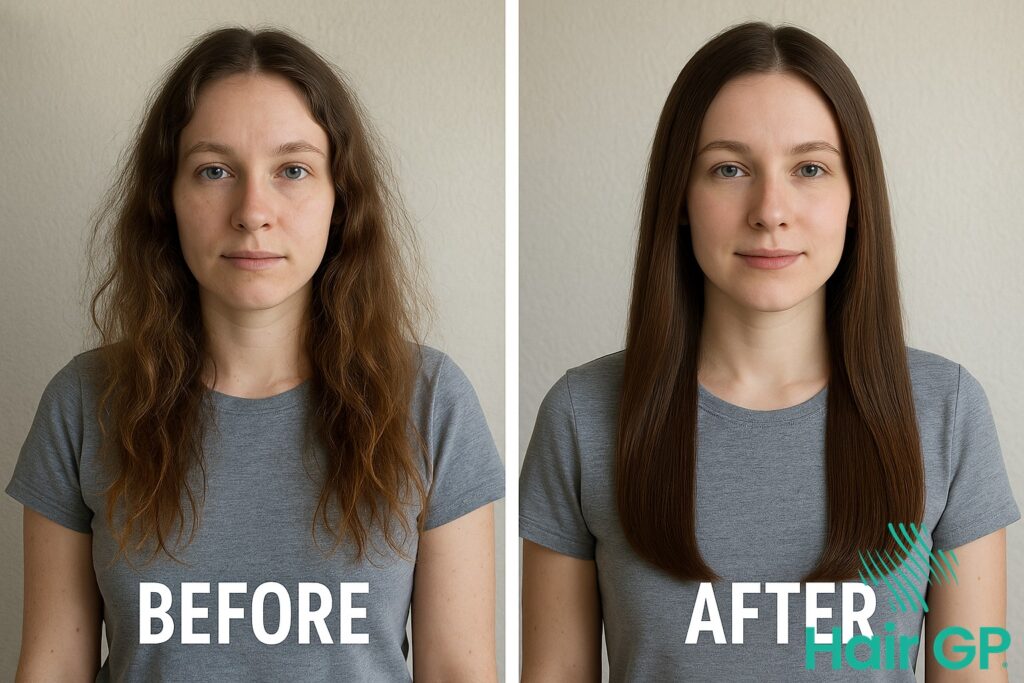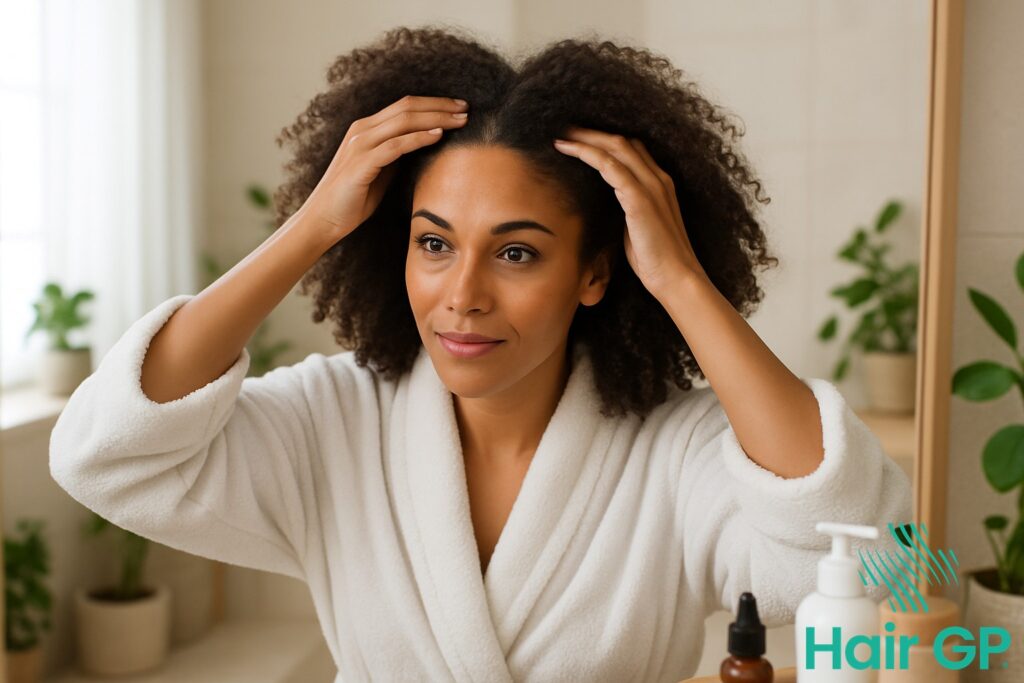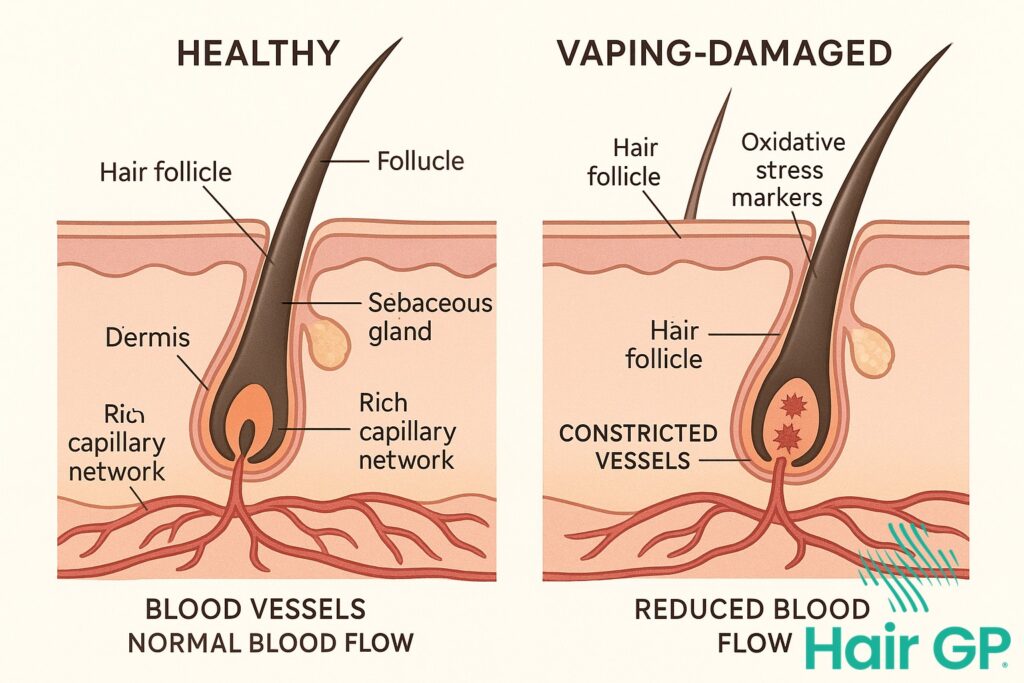Introduction
If you’ve ever wondered “Is Heat Damage Reversible — or Is My Hair Fried Forever?”, you’re not alone. Millions of people rely on heat styling tools daily, only to discover their once-healthy locks have transformed into dry, brittle strands that refuse to cooperate. The good news? Understanding heat damage is the first step towards rescuing your hair from its distressed state.
Heat damaged hair presents itself in various ways, from lost curl patterns to excessive breakage and that unmistakable straw-like texture. But before you panic about your damaged hair, it’s crucial to understand what’s actually happening beneath the surface. When we explore the science of how thermal styling affects your hair’s structure, we can better grasp which aspects of hair damage are temporary and which might require more drastic measures.
Whilst complete reversal isn’t always possible, there are effective ways to repair heat damaged hair and restore much of its former glory. From protein-rich treatments to specialised bonding systems, modern hair care offers numerous solutions for those seeking redemption. Prevention, however, remains your strongest defence against future damage.
Throughout this guide, we’ll examine proven treatment methods, essential prevention strategies, and how different hair types respond uniquely to thermal stress. Whether you have fine strands prone to damage or resilient curls that have lost their bounce, you’ll discover tailored approaches to address your specific concerns and help your hair recover from its heat-induced trauma.
Key Takeaways – TL/DR
- Heat damage occurs when high temperatures break down hair’s protein structure, causing irreversible changes to the hair shaft
- While you can’t completely reverse heat damage, treatments can improve appearance and manageability
- Prevention through heat protectants and proper styling techniques is more effective than attempting repair
- Severely damaged hair may require cutting, but mild damage can be managed with protein treatments and deep conditioning
What Is Heat Damage and How to Identify It
Heat damage occurs when excessive temperatures alter the protein structure within hair strands, fundamentally changing their physical properties and appearance. Understanding how to identify these changes through both visual and tactile assessment helps determine the extent of damage and appropriate treatment approaches.
Visual Signs of Heat Damage
The most obvious indicators of heat damage appear as visible changes to your hair’s structure and appearance. Split ends become increasingly common, as temperatures above 150°C cause the protective cuticle layer to lift and separate [1]. This structural breakdown manifests as frayed, fork-like endings that travel upward along the hair shaft.
Damaged hair often loses its natural lustre, appearing dull and lifeless despite regular washing. The smooth cuticle layer that normally reflects light becomes roughened and raised, creating a lacklustre appearance. For those with naturally textured hair, heat damage frequently results in loosened or completely lost curl patterns, with previously bouncy ringlets hanging limp and undefined.
Excessive hair breakage represents another telltale sign, with strands snapping at various lengths rather than just the ends. You might notice short, broken pieces accumulating on your bathroom floor or clothing throughout the day.
The Touch Test for Damaged Hair
Beyond visual cues, heat damaged hair exhibits distinct textural changes detectable through touch. Healthy hair feels smooth and manageable, whilst damaged strands develop a rough, straw-like texture that catches on fingers when running through.
Frizzy hair becomes increasingly difficult to manage, with strands refusing to lie flat regardless of styling efforts. The hair’s elasticity – its ability to stretch and return to its original length – diminishes significantly when proteins denature at temperatures exceeding 200°C [2]. This loss of elasticity makes hair prone to snapping during gentle stretching tests, indicating severe structural compromise.
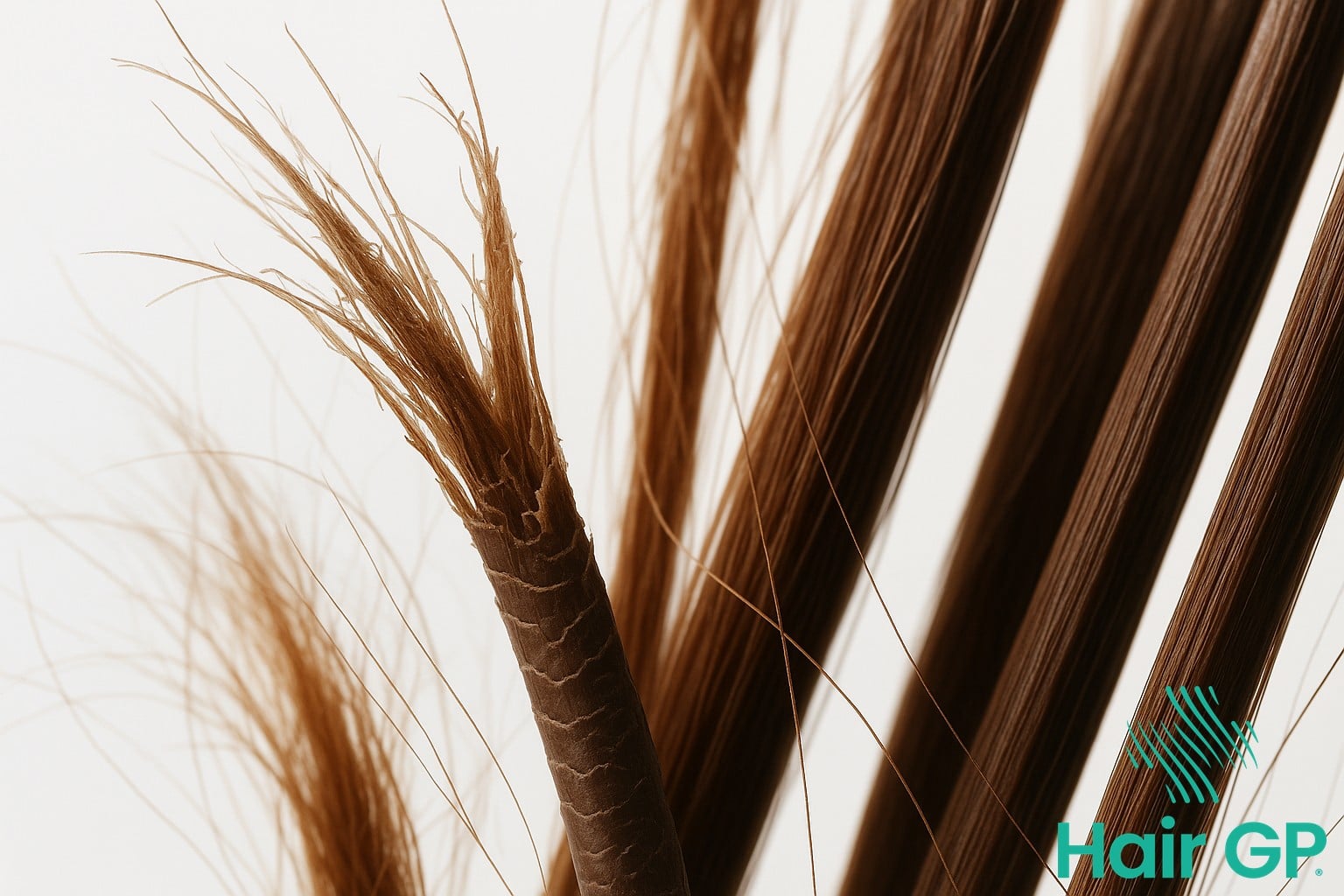
The Science Behind Heat Damage to Hair
Heat styling fundamentally alters your hair’s molecular structure through complex chemical changes that begin the moment high temperatures touch your strands. When excessive heat penetrates the hair fibre, it disrupts the carefully organised keratin proteins that give hair its strength and flexibility, leading to damage that ranges from temporary to permanently irreversible.
How Heat Affects Hair Structure
The impact of heat on hair begins at the outermost layer—the hair cuticle. When temperatures exceed 150°C, the protective cuticle scales start lifting and separating from the hair shaft [3]. This cuticle lifting creates gaps that allow moisture to escape rapidly, leading to dehydration of the inner cortex where most of the hair’s keratin resides.
As temperatures climb higher, protein denaturation occurs within the hair fibre. The alpha-helical structure of keratin begins unwinding at approximately 233°C, though structural changes can occur at lower temperatures with prolonged exposure [2]. This denaturation process breaks down the organised protein structure, causing the hair strands to lose their natural elasticity and strength. The result is high porosity hair that struggles to retain moisture and feels rough to the touch.
Moisture loss compounds these structural changes. Heat causes water molecules within the hair shaft to evaporate rapidly, disrupting the hydrogen bonds that help maintain hair’s flexibility. Without adequate hydration, the hair fibre becomes brittle and prone to breakage.
Why Some Damage Is Permanent
Not all heat damage can be reversed, and understanding why requires examining the types of bonds within your hair. Whilst hydrogen bonds can reform when hair is rewetted, broken disulfide bonds represent irreversible damage. These strong chemical bonds give hair its permanent structure, and once severed by extreme heat, they cannot naturally reconnect.
Structural protein loss occurs when heat literally degrades the keratin molecules beyond repair. This loss reduces the hair’s overall density and compromises its integrity. Combined with severe cuticle erosion, where the protective scales are completely worn away, the damage becomes permanent. No treatment can regenerate lost protein or rebuild eroded cuticles—only cutting away the damaged portions truly removes this irreversible harm.
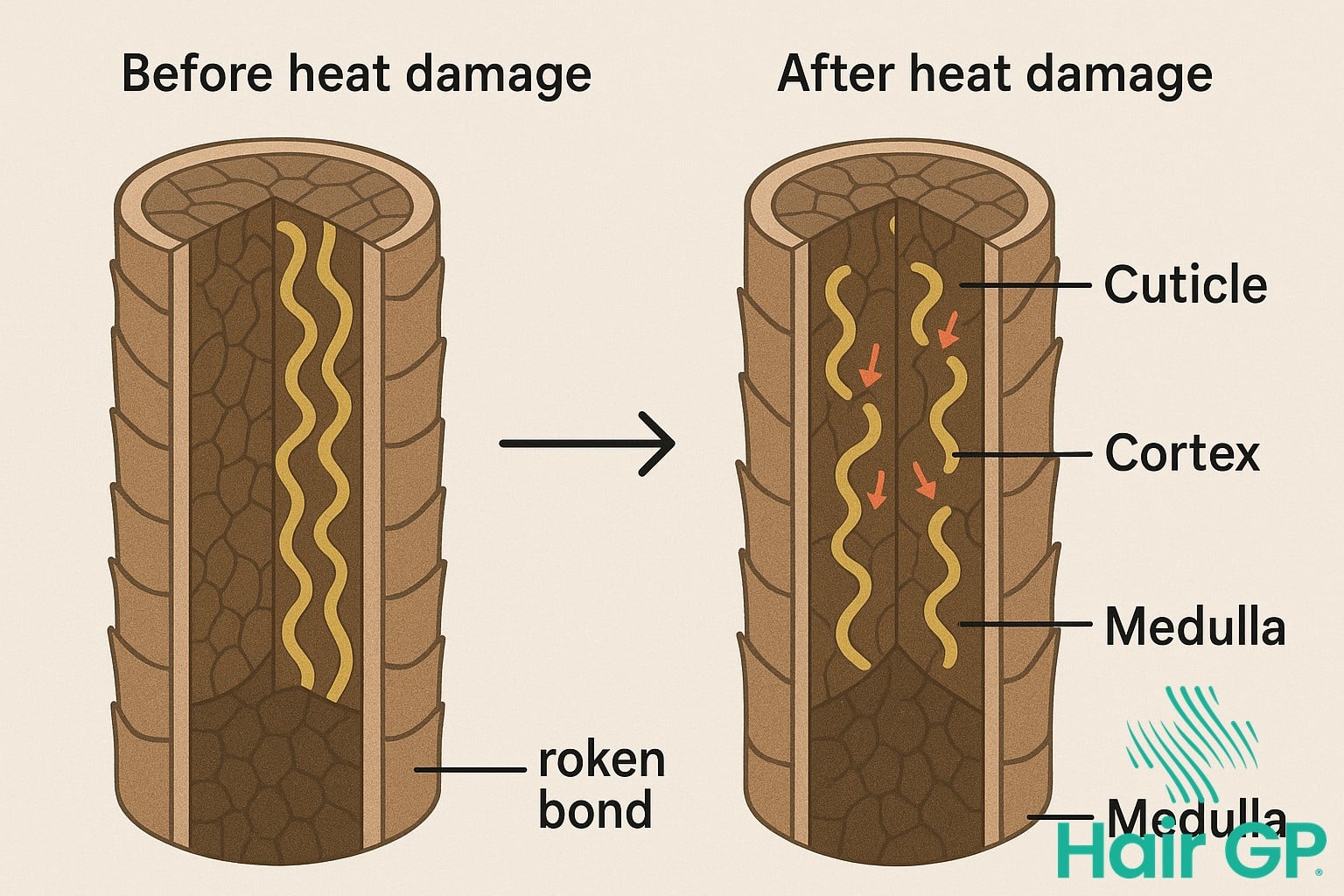
Can You Actually Repair Heat Damaged Hair?
Whilst numerous products promise to repair heat damaged hair, understanding the distinction between genuine repair and cosmetic improvements proves crucial for setting realistic expectations. Scientific evidence reveals significant limitations in reversing structural damage, despite marketing claims suggesting otherwise.
The Truth About Hair Repair Products
Most treatments claiming to repair damaged hair actually provide temporary surface improvements rather than permanent restoration. Research demonstrates that protein treatments can temporarily fill gaps in damaged cuticles, creating smoother surfaces and improved appearance[2]. However, these treatments cannot reconstruct broken disulphide bonds or restore the hair’s original protein structure once compromised by excessive heat.
The reality of internal damage contradicts common heat damage denial amongst consumers. Once the cortex experiences thermal degradation, no topical treatment can reverse these molecular changes. Products may mask symptoms through conditioning agents and protective coatings, but the underlying structural alterations remain unchanged.
Managing vs Reversing Damage
Rather than pursuing impossible reversal, focusing on damage management offers more realistic outcomes for hair health. Improvement strategies include regular protein treatments, which studies show can reduce breakage by up to 70% in moderately damaged hair[4]. Deep conditioning treatments help maintain moisture balance, whilst protective styling minimises further deterioration.
Damage mitigation involves adjusting expectations and recognising when cutting becomes necessary. In other words heat damage management requires accepting that severe alterations cannot be undone. Maintaining healthy hair means preventing additional damage whilst optimising the condition of existing strands through consistent care routines. When damage proves extensive, removing affected portions often provides the most effective path to recovery.
Treatment Options for Heat Damaged Hair
Whilst heat damage cannot be reversed, various treatment strategies can significantly improve your hair’s appearance and manageability. From protein treatments to strategic trimming, understanding which approaches work best for your specific damage level helps create an effective recovery plan with realistic expectations.
Protein and Moisture Treatments
Achieving the right balance between protein treatments and moisture is crucial for heat-damaged hair recovery. Protein treatments should be applied every 4-6 weeks, depending on damage severity, to temporarily fill gaps in the hair’s keratin structure. However, overuse can lead to brittleness, making moisture balance essential. Deep conditioning treatments should be incorporated weekly, focusing on ingredients like glycerin and natural oils that penetrate the hair shaft. When selecting treatments, assess whether your dry hair feels brittle (needs moisture) or stretchy (needs protein) to guide your choice.
The Role of Regular Trims
Strategic trimming remains the only permanent solution for removing heat damage whilst supporting healthy hair growth. Schedule trims every 6-8 weeks, removing approximately 6mm to prevent damage from travelling up the hair shaft. The dusting technique, which removes only the damaged ends whilst preserving length, proves particularly effective for those wanting to maintain hair growth progress. This method involves cutting just 3mm every 4-6 weeks, allowing you to grow out damage gradually whilst keeping hair looking healthy. Remember that proper detangling before trimming ensures even cuts and prevents further breakage.
Bond Repair Systems
Modern bond repair treatments work by reconnecting broken disulphide bonds within the hair structure, offering temporary but significant improvement in hair strength and appearance. These systems penetrate wet hair during application, creating new bonds that last through several washes. Realistic results include 50-70% improvement in hair smoothness and reduced breakage, though complete restoration isn’t possible. Maintenance requires reapplication every 4-6 treatments, with many users incorporating bond repairs into their regular deep conditioning routine. For severely damaged hair, combining bond treatments with protein therapies maximises structural support whilst improving manageability.
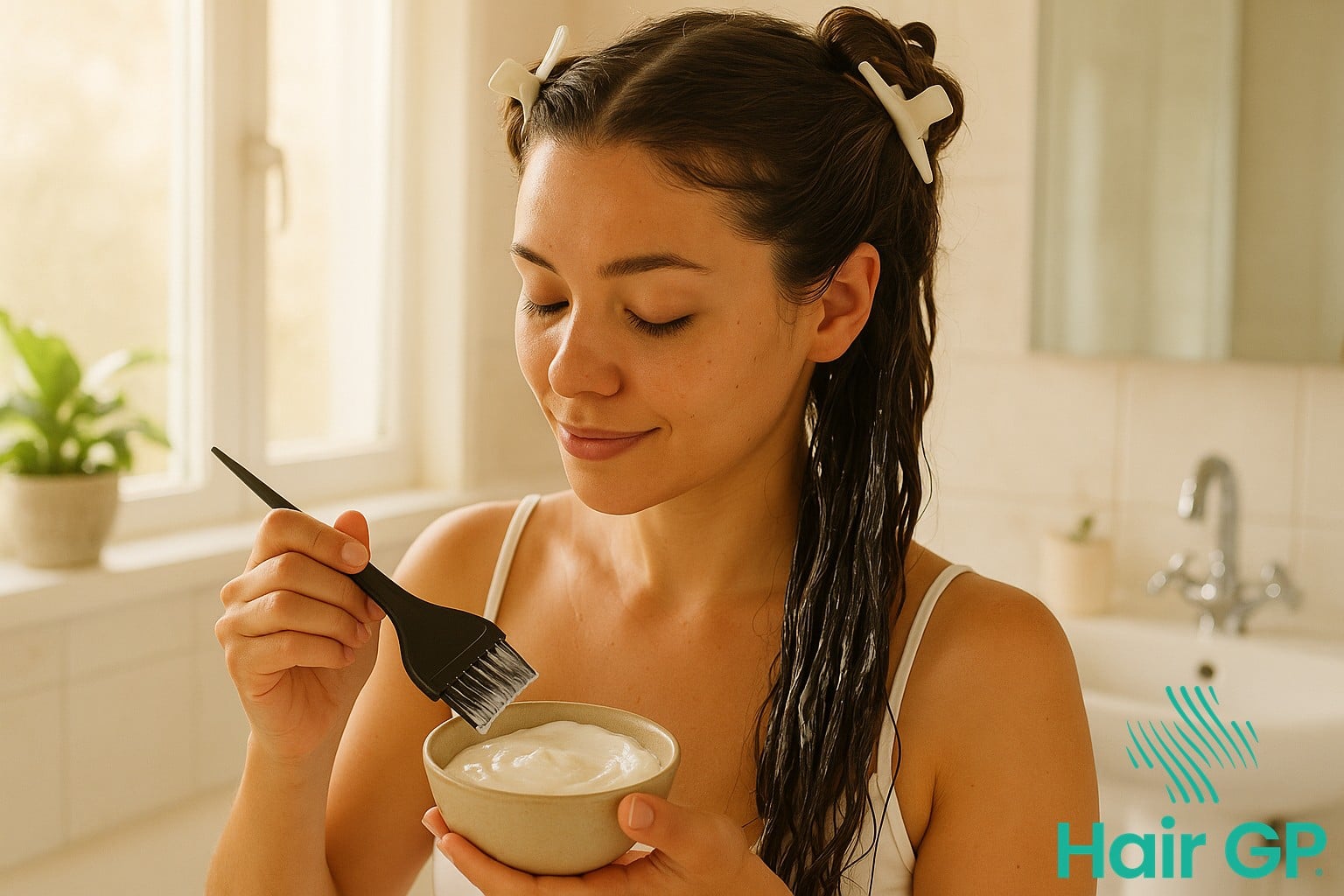
Preventing Future Heat Damage
Protecting your hair from future heat damage requires a proactive approach combining smart heat styling practices with damage-prevention techniques. By implementing proper protective measures and exploring alternative styling methods, you can maintain beautiful hair whilst minimising the risk of thermal damage.
Essential Heat Protection Strategies
Effective heat damage prevention begins with consistent heat protectant application before any thermal styling. Apply protectant products evenly throughout damp hair, concentrating on mid-lengths and ends where damage occurs most frequently. When using heat tools, maintain temperatures below 185°C for fine hair and 200°C for thicker textures.
Investing in quality hot tools with ceramic or tourmaline plates ensures even heat distribution, reducing the need for multiple passes. Always blow dry on medium heat settings, keeping the dryer moving constantly and maintaining a 15cm distance from hair strands.
Alternative Styling Methods
Embracing heat-free styling significantly reduces damage risk whilst achieving stunning results. Allow hair to air dry 70-80% before using minimal heat for finishing touches. Create beautiful waves using overnight braiding techniques or foam rollers, which provide long-lasting curls without thermal exposure.
Protective styles like loose buns, twists, and braids offer versatile options that keep hair styled whilst preventing heat damage. Experiment with texturising sprays, mousse, and styling creams designed for air-dried hair to enhance natural texture and maintain polished looks without relying on hot tools.
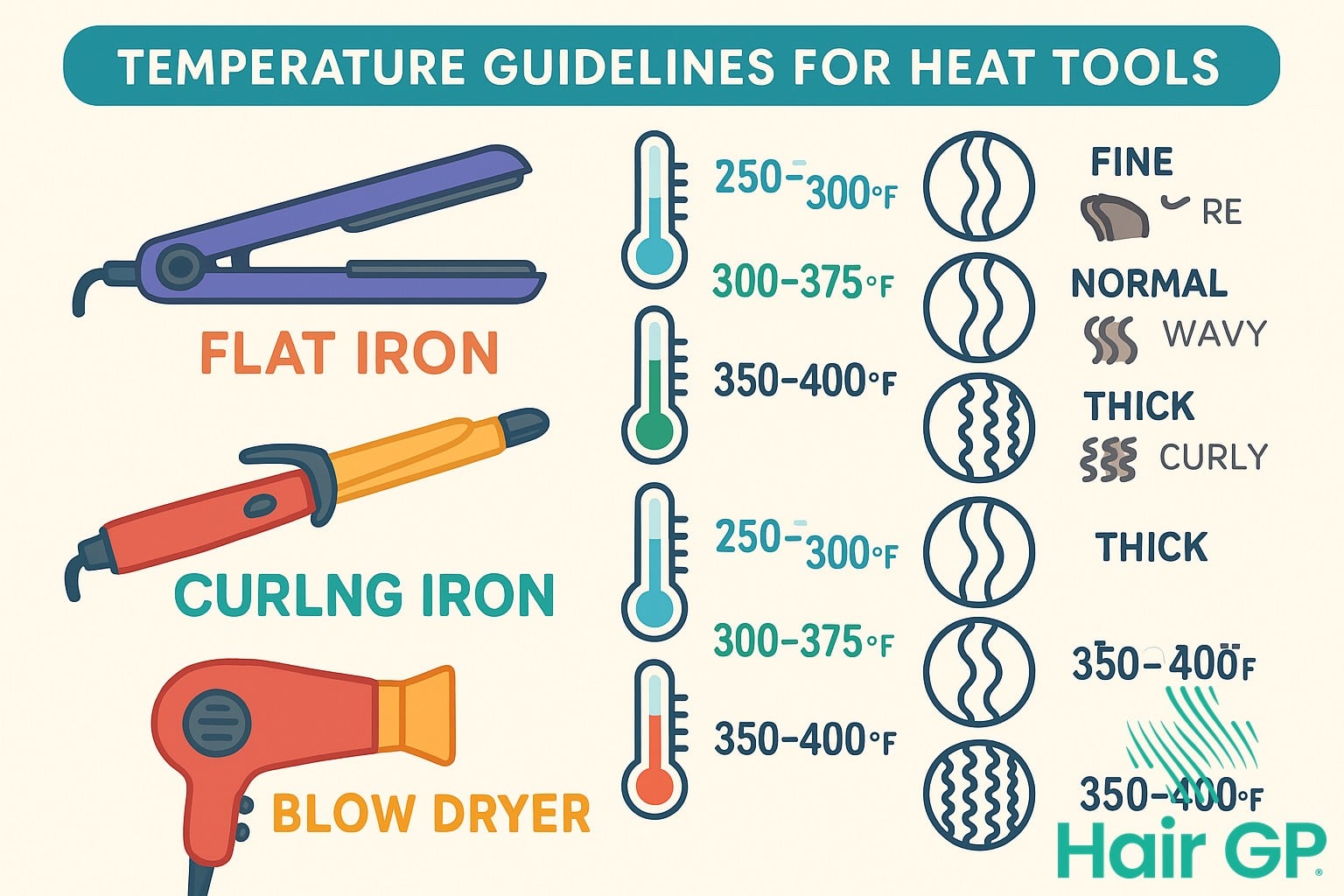
Special Considerations for Different Hair Types
Different hair types require tailored approaches to heat protection and damage prevention. Understanding your hair’s unique characteristics helps determine appropriate temperature settings, product selection, and styling techniques to minimise potential harm.
Fine and Fragile Hair
Fine hair demands extra caution with heat styling due to its delicate structure. These strands require significantly lower temperatures, typically below 150°C, to prevent immediate damage. Lightweight heat protectants work best, as heavier formulations can weigh down fine strands and cause limpness. Gentle handling proves essential—avoid aggressive brushing when heat styling and limit tool passes to prevent breakage.
Textured and Curly Hair
Textured hair, including afro hair and kinky hair patterns, faces unique challenges with heat damage. These natural hair types require intensive moisture retention strategies, as their structure makes hydration distribution challenging. Stretch methods, such as blow-drying with tension rather than flat ironing, help achieve desired styles whilst minimising direct heat exposure. Protective styling between heat applications allows recovery time, whilst deep conditioning treatments restore moisture balance. Regular protein treatments strengthen the hair shaft, though balance remains crucial to avoid protein overload in naturally drier textures.
Conclusion
The question “Is Heat Damage Reversible — or Is My Hair Fried Forever?” ultimately has a nuanced answer. Whilst true reversal of heat damage remains scientifically impossible, understanding this reality empowers more effective hair care decisions. The permanent alterations to protein structure cannot be undone, but this knowledge shouldn’t lead to despair.
Successfully managing heat-damaged hair requires accepting that efforts to repair heat damaged hair focus on improvement rather than restoration. Through consistent moisturising treatments, protein therapies, and protective styling, damaged strands can appear healthier and feel more manageable. Regular trimming removes the most severely damaged portions whilst allowing healthy hair to grow in their place.
Prevention remains paramount for maintaining optimal hair health. When heat styling is necessary, using thermal protectants, selecting appropriate temperatures, and limiting frequency can significantly reduce future damage. Consider embracing air-drying methods and heat-free styling alternatives whenever possible.
Remember that hair grows approximately six inches annually, meaning patience and consistent care eventually replace damaged sections with healthy growth. By combining realistic expectations with science-based treatments and preventive measures, you can achieve the healthiest possible hair despite past heat damage.
Frequently Asked Questions
Yes, new hair growth will be healthy if you protect it from heat damage. The damaged portions won’t repair themselves, but as your hair grows, you can gradually trim away the damaged sections while maintaining healthy new growth through proper care and heat protection.
With consistent treatment, you may see cosmetic improvements in 2-4 weeks. However, severely damaged hair won’t truly repair – you’ll need to grow it out and trim damaged ends over 6-12 months for complete renewal.
Keep tools below 350°F (175°C) for fine or damaged hair, and never exceed 400°F (205°C) for thick, healthy hair. Always use the lowest effective temperature and apply heat protectant before styling.
Taking a break from heat styling allows your hair to recover and prevents further damage. Try heat-free styling methods for at least 2-3 months while focusing on repair treatments. When you resume, use lower temperatures and better protection.
References
- Lee Y, Kim YD, Hyun HJ, Pi LQ, Jin X, Lee WS. Hair shaft damage from heat and drying time of hair dryer. Ann Dermatol. 2011. PMID: 22148012
- Gavazzoni Dias MF. Hair cosmetics: an overview. Int J Trichology. 2015. PMID: 25878443
- Lee Y, Kim YD, Pi LQ, Lee SY, Hong H, Lee WS. Comparison of hair shaft damage after chemical treatment in Asian, White European, and African hair. Int J Dermatol. 2014. PMID: 24261682
- Fernández E, Martínez-Teipel B, Armengol R, Barba C, Coderch L. Efficacy of antioxidants in human hair. J Photochem Photobiol B. 2012. PMID: 23123594

